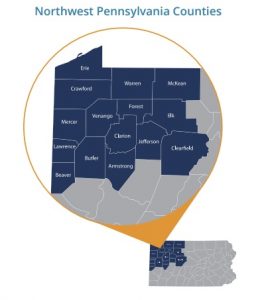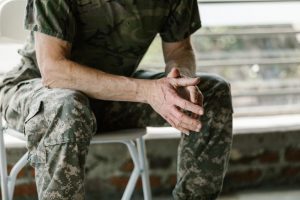Veteran Discharge Characterization: Suicide Attempts and Homelessness

The Northwest Pennsylvania (NW PA) Veteran Suicide Prevention Program operates on a three-pronged approach involving healthcare providers, community organizations, and Veterans and their families in the 15 counties of NW PA.
This article summarizes a research presentation by Lee Wagner, Senior Program Implementation Specialist, and explores the following topics:
- What is meant by a “bad paper” discharge?
- Results of surveys as they pertain to suicide and homelessness
- The connection between homelessness and suicide
Read time: 5 minutes
A pdf of the presentation, including sources, is available for download.
What are Discharge Characterizations?
 The Defense Manpower Data Center records the “character of service” for every military discharge. They are:
The Defense Manpower Data Center records the “character of service” for every military discharge. They are:
- Honorable
- General (under honorable conditions)
- Bad Conduct
- Dishonorable
- Uncharacterized
A “bad paper” discharge is any characterization other than honorable conditions, including bad conduct, dishonorable (dismissal for officers), or uncharacterized. The research discussed in this presentation sought to understand what, if any, connections lie between a “bad paper” discharge and the issues of Veteran suicide and homelessness. The last two decades have seen an increase in these issues for Veterans.
Methods, Data, and Screening Protocols
Data were analyzed from the STARRS – LS: Study to Assess Risk and Resilience in Servicemembers Longitudinal Study, which identified risk and protective factors for suicidal behaviors among U.S. Army soldiers. Three baseline survey periods between 2011 and 2014, with a total of 38,733 surveys, were reviewed. The research was limited to soldiers who completed the STARRS and then were available for a re-survey in 2016-2019.
Suicide attempts were assessed using questions adapted from the Columbia-Suicide Severity Rating Scale (4,338 observations). Homelessness data was collected using modified questions from the Veteran’s Health Administration’s Homelessness Screening Clinical Reminder (6,837 observations).
Suicide Screening Results

- No association between discharge characterization and suicide attempts was reported by participants.
- No respondents with “bad paper” discharges reported a suicide attempt during observations.
- Further research should be conducted to ensure that findings are consistent and not a factor of circumstance within this study.
Homelessness Screening Results
- Risk of homelessness was four times as high among soldiers with “bad paper” discharge as those with an honorable discharge.
- Findings were consistent across all facets of the study regardless of time elapsed.
- Further research needs to be completed to see if these results differ for male and female Veterans.
Addressing Veteran Suicide and Homelessness
 Although this article did not find a connection between bad paper discharges and suicide attempts, other research shows a connection between homelessness and suicide attempts.
Although this article did not find a connection between bad paper discharges and suicide attempts, other research shows a connection between homelessness and suicide attempts.
- In the US, the adult lifetime rate of attempted suicide is 5.3 times greater among individuals who had been homeless than individuals who had never been homeless.
- Among US Veterans, the lifetime rates of suicide attempts is 8.8 times greater among Veterans with homeless histories compared with Veterans with no homeless histories.
- Mental illness and substance use disorders (SUD) are among the strongest and most consistent predictors of homelessness among Veterans.
- These same factors are likely associated with misconduct and other behaviors that may lead to a “bad paper” discharge.
For discussion: How does the stigma associated with a “bad paper” discharge connect to future homelessness or suicidal ideation?
Source: Tsai, J., & Cao, X. (2019). Association between suicide attempts and homelessness in a population-based sample of US veterans and non-veterans. Journal of Epidemiology and Community Health, 73(4), 346–352. https://doi.org/10.1136/jech-2018-211065
Share Our Vision and Get Involved
Our Vision: The work of the Northwest Pennsylvania Veteran Suicide Prevention Program will result in resident Veteran suicides being reduced to zero by the end of the project period (August 31, 2025).
Whether you identify as a healthcare provider, community organization, or Veteran, there are several opportunities through the NW PA Veteran Suicide Prevention Program and PERU to connect to resources, participate in educational training, and promote harm reduction strategies. We are actively recruiting healthcare and community partners to work with us in meeting our goals and objectives. To learn more, visit the program website at theresilientveteran.org.
Need Help? Know Someone Who Does? Contact the National Suicide Prevention Lifeline at 988 or use the online Lifeline Crisis Chat. Both are free and confidential. You’ll be connected to a skilled, trained counselor in your area.

